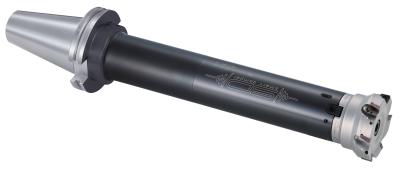
In order to offer more flexibility to customers, BIG KAISER has moved production of its CAT50 milling adapters to the U.S. The product performance and design will not change, but the move allows for more variation and faster delivery of special lengths for specific applications.
“The market has spoken,” Alan Miller, engineering and product manager, said. “As awareness of Smart Damper has spread, more and more customers have asked for specials for their unique projects. This allows us to do more of that without the delay of coordinating with our partners overseas and additional shipping time.”
With both a patented counter weight and friction damper, the Smart Damper is a dynamic damping system that eliminates vibration for higher productivity. It provides quiet, vibration-free milling with long projection tools, ultimately making it easier to achieve fine surface finishes and higher metal removal rates.
Smart Damper adapters are also available for turning and boring applications.
Contact Details
Related Glossary Terms
- boring
boring
Enlarging a hole that already has been drilled or cored. Generally, it is an operation of truing the previously drilled hole with a single-point, lathe-type tool. Boring is essentially internal turning, in that usually a single-point cutting tool forms the internal shape. Some tools are available with two cutting edges to balance cutting forces.
- gang cutting ( milling)
gang cutting ( milling)
Machining with several cutters mounted on a single arbor, generally for simultaneous cutting.
- milling
milling
Machining operation in which metal or other material is removed by applying power to a rotating cutter. In vertical milling, the cutting tool is mounted vertically on the spindle. In horizontal milling, the cutting tool is mounted horizontally, either directly on the spindle or on an arbor. Horizontal milling is further broken down into conventional milling, where the cutter rotates opposite the direction of feed, or “up” into the workpiece; and climb milling, where the cutter rotates in the direction of feed, or “down” into the workpiece. Milling operations include plane or surface milling, endmilling, facemilling, angle milling, form milling and profiling.
- turning
turning
Workpiece is held in a chuck, mounted on a face plate or secured between centers and rotated while a cutting tool, normally a single-point tool, is fed into it along its periphery or across its end or face. Takes the form of straight turning (cutting along the periphery of the workpiece); taper turning (creating a taper); step turning (turning different-size diameters on the same work); chamfering (beveling an edge or shoulder); facing (cutting on an end); turning threads (usually external but can be internal); roughing (high-volume metal removal); and finishing (final light cuts). Performed on lathes, turning centers, chucking machines, automatic screw machines and similar machines.

